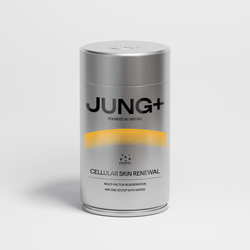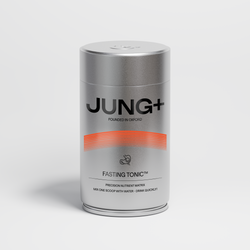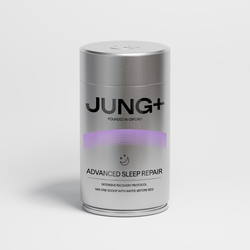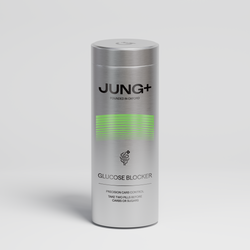The 12 Hallmarks of Aging: What to Look For & Why They Matter
For thousands of years, the word "aging" was simply used to define a singular process—getting older. However, recent scientific research has unveiled 12 specific mechanisms that drive the aging process.
Some of the most well-known signs of aging include wrinkles, gray hair, and muscle, which tend to increase with the number of years lived (chronological age). However, these are only visible manifestations of deeper processes happening in our cells and bodies. In other words, there's a lot going on inside our bodies, under the surface, that contributes to symptoms of aging.
In this article, you'll learn about the 12 hallmarks of aging, their effects on the aging process, and how you can slow down their impact to promote longevity and a greater quality of life into older age.
What Makes Us Age?
While we still don't fully understand the exact aging process and all the hidden changes in our cells and bodies that have taken place over many decades, scientists have discovered specific ways to monitor and potentially slow down aging at the cellular level. These are known as the "hallmarks of aging," and they have advanced the science of longevity.
Why are these hallmarks important?
The hallmarks of aging are interconnected mechanisms that can be studied, understood, and influenced to some extent to help us live longer, healthier lives.
Imagine the human body as a complex car that experiences wear and tear over time. With proper maintenance, quality oil, and regular checkups, we can likely help extend the car's lifespan.
The human body works much the same way—it requires a number of nutrients, as well as quality sleep, exercise, and other forms of care to keep it thriving.
12 Hallmarks of Aging
The "12 Hallmarks of Aging" include: (1)
- Telomere Attrition: Shortening of protective caps on chromosomes.
- Loss of Proteostasis: Decline in protein folding and recycling.
- DNA Instability: Damage and mutations in our genetic material.
- Epigenetic Alterations: Changes in how genes are expressed.
- Deregulated Nutrient Sensing: Issues with how the body processes energy.
- Mitochondrial Dysfunction: Decline in the function of cellular powerhouses.
- Cellular Senescence: Cells lose the ability to divide and function properly.
- Stem Cell Exhaustion: Decreased ability of stem cells to regenerate tissue.
- Altered Intercellular Communication: Problems with how cells communicate.
- Disabled Macroautophagy: Reduced recycling of damaged cell parts.
- Chronic Inflammation: Persistent inflammation that can damage tissues, interfere with hormone production, and contribute to chronic diseases.
- Microbiota Imbalance (Dysbiosis): Changes in the gut bacteria composition.
Now, let's look at each hallmark more closely to understand its underlying process and how to
target it in order to support longevity:
1. Telomere Attrition
What is it?
- Telomeres are protective caps at the ends of chromosomes that prevent them from sticking together. Think of them like the plastic tips on shoelaces. (2)
Why does it matter?
- With each cell division, telomeres shorten. When telomeres become too short, cells can not divide anymore. This shortening is linked to cellular aging and chronic conditions.
How to protect telomeres:
- Astragalus Root Extract: Modulates telomerase activity, supporting telomere health.(6)
- Astaxanthin: An antioxidant that reduces oxidative stress-induced DNA damage.(3)
- Niacin: Offers protection against oxidative stress and supports telomere length. (4)
- Zinc: Known for its anti-inflammatory and immunomodulatory properties.(5)
- Limit stressors, including smoking, excessive alcohol, pollution, obesity, and chronic stress.
2. Loss of Proteostasis
What is it?
- Proteostasis is the process of keeping proteins (made up of amino acids) correctly folded and functional. It is one of the most important processes in the body as it's needed for nearly all processes, including to repair and maintain tissues that form muscles, organs, and more.
Why does it matter?
- As we age, the body accumulates misfolded or oxidized proteins, leading to a higher risk for diseases such as Alzheimer’s, Parkinson’s, and ALS (amyotrophic lateral sclerosis).(7)(8)
How to support proteostasis:
- Niacin: Protects proteins from oxidative stress.(4)
- Quercetin & Fisetin: Antioxidants that improve proteostasis.(9)(10)
- Spermidine: Promotes cellular repair and proteostasis.(11)
3. Epigenetic Alterations
What is it?
- Epigenetic regulation includes DNA methylation, histone modification, chromatin remodeling, and non-coding RNA regulation. These processes provide our bodies with a blueprint for how to build and repair our cells, organs, and systems.
Source: Epigenetics in the Vascular Endothelium
Why does it matter?
- Over time, errors in epigenetic regulation accumulate, affecting cellular processes and contributing to aging and diseases. Epigenetic changes are correlated with many conditions, including cancer, neurodegenerative diseases, and autoimmune diseases.(12)(13)
How to support healthy epigenetics:
- Pterostilbene: Reduces tumor risk and modulates epigenetic modifications.(14)
- Olive Leaf Extract: Modulates histone modifications and DNA methylation.(15)
- Spermidine: Involved in transcription and epigenetic regulation.(16)
4. Deregulated Nutrient Sensing
What is it?
- The failure of the pathways that regulate metabolism and control energy production. Our metabolism plays a central role in the normal functioning of cells, tissues, organs, and the entire body. The substances we consume and our bodies process them primarily affect energy production in our cells, affecting our daily energy for activities, mood, and performance.(17)
The four pathways that control metabolism are:
- Insulin/IGF-1: Regulates metabolism and growth.(18)
- mTOR: Controls metabolism in crucial tissues.(19)
- Sirtuins: Signaling proteins involved in longevity.(20)
- AMPK: Key energy homeostasis regulator.(21)
How to support nutrient sensing:
- Quercetin, Niacin & Spermidine: Reduce oxidative stress.(9)(4)(11)
- Olive Leaf Extract: Activates AMPK and SIRT1.(22)
- Pterostilbene & Zinc: Combat inflammation.(23)(24)
- Calcium alpha-ketoglutarate: Facilitates energy production and the metabolism of nutrients. (25)
5. Mitochondrial Dysfunction
What is it?
- Mitochondria, the cell's powerhouses, undergo dysfunction with aging. Under normal conditions, mitochondria undergo regular renewal, producing controlled amounts of reactive oxygen species and participating in ATP synthesis, the cell's primary energy source.
As aging progresses, several changes affecting mitochondria occur:(26)(27)
- Their total number decreases;
- Their internal structure is disturbed;
- The total amount of mtDNA decreases (mitochondria have their own DNA);
- Various damages accumulate in mtDNA;
- Mitochondrial quality control processes, including mitophagy (removal of damaged mitochondria) and biogenesis (formation of new mitochondria).
How to support mitochondrial health:
- Niacin, Astaxanthin & Spermidine: Key antioxidants.
- Apigenin: Flavonoid that possesses antioxidant, anti-inflammatory, and anti-cancer properties and contributes to cellular homeostasis.(28)
6. Cellular Senescence
What is it?
- Cellular senescence is a process where cells cannot divide, and they release harmful substances that can cause inflammation and damage to nearby healthy cells.(29)(30)
Why does it matter?
- Senescent cells secrete pro-inflammatory molecules known as the senescence-associated secretory phenotype (SASP). They promote inflammation and impact neighboring cells, accelerating aging. The accumulation of senescent cells is related to age-associated tissue pathologies such as osteoarthritis, atherosclerosis, and liver cirrhosis.(31)(32)(33)
How to reduce senescence:
- Fisetin & Quercetin: Senotherapeutic agents that reduce senescent cells.
- Spermidine: Encourages cellular renewal.
7. Stem Cell Exhaustion
What is it?
- Stem cells are undifferentiated cells that can transform into different cell types. Stem cells are often referred to as the "architects of regeneration" and contribute to tissue repair, regeneration, and growth. Stem cell exhaustion occurs when these cells age and lose their regenerative abilities.
Why does it matter?
- Stem cell depletion reduces the number of functional stem cells in the body, impacting the overall ability to regenerate and renew itself. This process is known as stem cell exhaustion.(35)
How to support stem cells:
- Astragalus Root Extract & Niacin: Protect against stem cell aging.
- Calcium Alpha-Ketoglutarate (Ca-AKG): Supports nutrient metabolism and energy production.
8. Altered Intercellular Communication
What is it?
- Changes in the way cells exchange information via signaling molecules, cell-to-cell contact, or extracellular vesicles.
Why does it matter?
- Altered communication can lead to aging and diseases, affecting processes like inflammation and tissue degeneration.
How to improve cellular communication:
- Quercetin & Pterostilbene: Reduce inflammatory signaling.
- Olive Leaf Extract: Modulates signaling pathways.
9. Disabled Macroautophagy
What is it?
- Macroautophagy is the process by which cells degrade and recycle their own components.
Why does it matter?
- Autophagic activity tends to decrease with age, leading to a loss of proteostasis and an increase in the number of senescent cells. Additionally, this process is a vicious cycle: oxidative stress, DNA, and protein damage can impair autophagy, and its impairment, in turn, leads to an increase in damage.
How to support autophagy:
- Olive Leaf Extract: Activates AMPK/mTOR pathways to induce autophagy.
- Spermidine & Pterostilbene: Promote cellular recycling.
10. Chronic Inflammation
What is it?
- Chronic inflammation is long-term inflammation that can accelerate aging processes. It can result from a weakened or overactive immune system, which can be tied to gut dysfunction and accumulation of senescent cells. Aging immune system cells can activate senescence in healthy tissues, creating a feedback loop; senescent cells weaken immunity, and weakened immunity promotes an increase in the number of senescent cells.(36)(37)(38)
Why does it matter?
- It contributes to cellular aging, tissue damage, and many types of chronic diseases, including osteoporosis, atherosclerosis, and neurodegenerative diseases.
How to reduce inflammation:
- Quercetin & Fisetin: Natural anti-inflammatories.
- Zinc & Spermidine: Support immune health and reduce inflammation.
11. Dysbiosis
What is it?
- Dysbiosis is an imbalance in the microbiome of various microbes (including bacteria and yeast). Research suggests age-related changes occur in the aging microbiome including changes in gut composition towards a decrease in species diversity and a decrease in the total number of bacteria.(39)(40)
Why does it matter?
- It impacts digestion, immunity, inflammation, and brain function, contributing to aging processes.
How to support gut health:
- Probiotics & Prebiotics: Replenish beneficial bacteria.
- Spermidine: Support gut lining renewal.
12. DNA (or Genomic) Instability
What is it?
- Accumulated damage of DNA that leads to alterations in protein folding and cell cycles.
Why does it matter?
- DNA instability boosts senescence and contributes to tissue degeneration, diseases, and aging.(41)
How to protect DNA:
- Astaxanthin & Niacin: Key antioxidants that reduce DNA damage.
- Pterostilbene & Zinc: Combat oxidative stress and inflammation.
How to Address the Hallmarks of Aging
To mitigate the 12 hallmarks of aging, consider these proactive steps:
- Anti-Aging Supplements: Use scientifically formulated supplements that have been shown to target the hallmarks of aging.
- Regular Exercise: Physical activity promotes mitochondrial health and muscle strength and reduces inflammation.
- Quality Sleep: Seven to nine hours of sleep per night supports cognitive function and cellular repair.
- Balanced Diet: Emphasize whole, nutrient-dense foods, including quality proteins, vegetables, fruits, nuts, seeds, legumes, herbs, and spices.
- Intermittent Fasting: Fasting encourages autophagy and senescence protection.
- Manage Blood Sugar: Consume a low-glycemic diet, try fasting, get enough sleep, and exercise to regulate glucose spikes and promote insulin sensitivity.
- Manage Stress: Reduce high cortisol levels by engaging in relaxation techniques, getting adequate sleep, breathwork, meditation, and exercising moderately.
- Form Deep Social Relationships: Supportive relationships help reduce stress and have positive effects on cognitive health and hormonal balance.
Key Takeaways:
- The hallmarks of aging are interconnected mechanisms that accelerate aging.
- By targeting these hallmarks through supplements, lifestyle changes, and medical guidance, you can slow the aging process.
Discover our line of anti-aging supplements designed to support your body's fight against aging.
References
- Hallmarks of aging: An expanding universe (2023). Cell.
- Telomeres, lifestyle, cancer, and aging (2012). Current Opinion in Clinical Nutrition and Metabolic Care.
- Astaxanthin decreased oxidative stress and inflammation and enhanced immune response in humans (2010). Nutrition and Metabolism.
- Niacin and Oxidative Stress: A Mini-Review (2016). Journal of Nutritional Medicine and Diet Care.
- Potential effect of dietary zinc intake on telomere length: A cross-sectional study of US adults (2022). Frontiers in Nutrition | Nutritional Epidemiology.
- The Use of Natural Agents to Counteract Telomere Shortening: Effects of a Multi-Component Extract of Astragalus mongholicus Bunge and Danazol (2020). Biomedicines.
- The proteostasis network and its decline in ageing (2019). Nature Reviews Molecular Cell Biology.
- Proteostasis Failure in Neurodegenerative Diseases: Focus on Oxidative Stress (2020). Oxidative Medicine and Cellular Longevity.
- Health Benefits of Quercetin in Age-Related Diseases (2022). Molecules.
- Fisetin as a Senotherapeutic Agent: Biopharmaceutical Properties and Crosstalk between Cell Senescence and Neuroprotection (2022). Molecules.
- Investigating the Role of Spermidine in a Model System of Alzheimer’s Disease Using Correlative Microscopy and Super-resolution Techniques (2022). Frontiers in Cell and Developmental Biology.
- Epigenetic regulation of aging: implications for interventions of aging and diseases (2022). Signal Transduction And Targeted Therapy.
- Role of Epigenetics in Biology and Human Diseases (2016). Iranian Biomedical Journal.
- Chemoprevention by resveratrol and pterostilbene: Targeting on epigenetic regulation (2018). Biofactors.
- Oleuropein aglycone protects against pyroglutamylated-3 amyloid-ß toxicity: biochemical, epigenetic and functional correlates (2015). Neurobiology of Aging.
- The effect of spermine on transcription of mammalian chromatin by mammalian deoxyribonucleic acid-dependent ribonucleic acid polymerase (1975). Biochemical Journal.
- The Hallmarks of Aging (2013). Cell.
- Role of insulin/insulin-like growth factor 1 signaling pathway in longevity (2005). World Journal of Gastroenterology.
- The mechanistic Target of Rapamycin: The grand conducTOR of metabolism and aging (2017). Cell Metabolism.
- Sirtuins as regulators of metabolism and healthspan (2012). Nature Reviews Molecular Cell Biology.
- The role of the AMP-activated protein kinase in the regulation of energy homeostasis (2007). Novartis Foundation Symposia.
- Oleuropein aglycone induces autophagy via the AMPK/mTOR signalling pathway: a mechanistic insight (2015). Oncotarget.
- Zinc, aging, and immunosenescence: an overview (2015). Pathobiology of aging and age related diseases.
- Autophagy-inducing effect of pterostilbene: A prospective therapeutic/preventive option for skin diseases (2017). Journal of food and drug analysis.
- Alpha-Ketoglutarate dietary supplementation to improve health in humans (2022). Trends in Endocrinology and Metabolism.
- Mitochondrial respiratory-chain diseases (2003). New England Journal of Medicine.
- The Mitochondrial Basis of Aging and Age-Related Disorders (2017). Genes (Basel).
- The natural plant flavonoid apigenin is a strong antioxidant that effectively delays peripheral neurodegenerative processes (2019). Anatomical Science International.
- Cellular senescence: the good, the bad and the unknown (2022). Nature Reviews Nephrology.
- DNA damage response and cellular senescence in tissues of aging mice (2009). Aging Cell.
- DNA Homeostasis and Senescence: Lessons from the Naked Mole Rat (2021). International Journal of Molecular Sciences.
- Senescence at a glance (2013). Journal of Cell Science.
- Impact of senescence‐associated secretory phenotype and its potential as a therapeutic target for senescence‐associated diseases (2017). Cancer Science.
- Intercellular communication and aging (2023). 257-274. In book: Aging.
- Autophagy and the hallmarks of aging (2021). Ageing Research Reviews.
- Senescence surveillance of pre-malignant hepatocytes limits liver cancer development (2011). Nature.
- The beginning of the end (2013). Nature.
- An aged immune system drives senescence and ageing of solid organs (2021). Nature.
- The human superorganism - of microbes and men (2010). Medical Hypotheses.
- Gut Microbiome (2015). Nutrition in Clinical Practice.
- Genomic Instability and Cancer (2014). Journal of Carcinogenesis and Mutagenesis.









